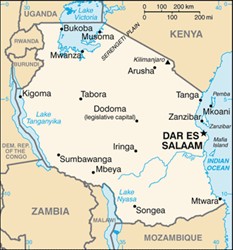
Country Background
Shortly after achieving independence from Britain in the early
1960s, Tanganyika and Zanzibar merged to form the nation of the
United Republic of Tanzania in 1964. One-party rule came to an end
in 1985 with the first democratic elections held in the
country. The country has since then been practicing
multi-party democracy with elections being held every five
years.
Tanzania has frontier to the following
countries
North : Kenya and Uganda
West: Rwanda, Burundi and
Democratic Republic of Congo
South: Zambia, Malawi and
Mozambique
Climate
Tanzania has a tropical type of climate. In the highlands,
temperatures range between 100c and
200c.during cold and hot seasons respectively. The rest
of the country has temperatures never falling lower than
200c. The hottest period spreads between November and
February (250c - 310c) while the coldest
period occurs between May and August (150c -
200c).
Two rainfall regimes exist over Tanzania. One is unimodal (December
- April) and the other is bimodal (October -December and March -
May). The former is experienced in southern, south-west, central
and western parts of the country, and the later is found to the
east, north and northern coast.
Population
Estimated at 42 million people in 2010.
Economy - overview
The economy depends heavily on agriculture, which accounts
for more than one-fourth of GDP, provides 85% of exports, and
employs 80% of the work force. Topography and climatic conditions,
however, limit cultivated crops to about 4% of the land area.
Government is giving much emphasis to agriculture development
through the Kilimo Kwanza (Agriculture First) initiative.
Industry traditionally features the processing of agricultural
commodities, cement and consumer goods.
The country is endowed with a variety of minerals which include,
inter alia, gold, coal, diamonds, uranium and iron ore.
Natural gas is in abundance and is being used to generate
electricity for the country. Generally, mining is still at
its infancy in Tanzania with a lot of exploration taking place
around the country.
Tanzania has some of the best unexploited national parks
boasting among them the world famous Serengeti and Ngorongoro
Conservation Area. Tourism is booming and attracting a lot of
investors.
There is also emphasis on energy and infrastructure development
which has not been given much attention in the past. The
Government is encouraging Private Public Partnership in the
implementation of some of the projects in these areas.